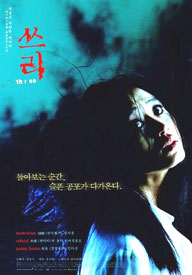 Three Extremes (2004) had a major launch for big-screen release in America in 2005 but it fell flat on its face. It apparently did okay in the dvd market, however, as it induced the release of Three Extremes 2; aka, 3 Extremes II (2002) direct to video.
Three Extremes (2004) had a major launch for big-screen release in America in 2005 but it fell flat on its face. It apparently did okay in the dvd market, however, as it induced the release of Three Extremes 2; aka, 3 Extremes II (2002) direct to video.
This "second" omnibus actually came out first & was originally called Three & was followed in 2004 with what was initially titled 2-Three (or Three-2). So only in the western market are their order reversed.
Three Extremes 2 is not the equal of the 2005 omnibus because nothing could equal Miike's Box.
Two of the little horror films from the 2002 trio of short films are no great shakes. Memories is okay but will seem very old-hat to anyone who has seen more than a couple Asian horror films. The Wheel is worth putting up with for its use of Thai puppetry as its central images of horror. But the third & closing tale Going Home is a work of art.
I must admit I almost gave up on this trio of films after the first two seemed tediously long when in fact they were short. But reminding myself the best is often saved for last, I hoped the third of three directors would make the whole thing seriously worthwhile, as it most sincerely did.
South Korean horrormeister Kim Jee-Woon's Memories opens the set. A man (Bo-seok Jeong) wakes from a nap on the sofa & sees the standard-issue long-haired ghost of a woman (Hye-su Kim) seated on the floor, rocking to & fro, weeping in the gloom of dusk.
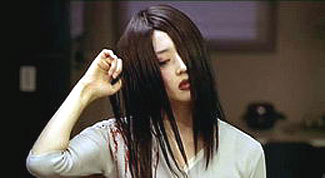 If its eerie minimalism for Basic Ghost Woman weren't by now such a cliche it might've been effective. If its eerie minimalism for Basic Ghost Woman weren't by now such a cliche it might've been effective.
On an empty street elsewhere in the city, the young woman awkens, confused, with no idea how she came to be lying on the road.
She stands & walks slowly away, like a somnambulant. She doesn't know who she is, & has set forth in search of her identity. No one acknowledges her presence. It seems she may well be a ghost unware she is dead.
Soon we learn that the young man's wife is missing. No one knows why she left or where she's gone. But in fact he & his daughter are haunted by the woman's ghost struggling to remember herself & to return.
It's moody & in the main well done but simply too commonplace for Asian horror films. I just wasn't at all wowed, though I had really liked Kim Jee-woon's A Tale of Two Sisters (2004).
Second up is The Wheel built around beliefs about traditional Thailand puppets & puppetry, by Nonzee Nimibutr, the director of Nang Nak (1999).
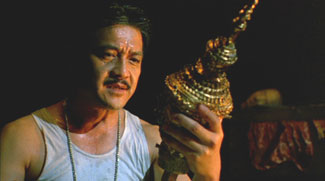 The "hun lakorn lek" puppeteers are regarded as great artists, their puppets as national treasures, not to be confused with the "khon" street performers who are of low social status who do an imitation of the great art but are regarded as little more than beggars. The "hun lakorn lek" puppeteers are regarded as great artists, their puppets as national treasures, not to be confused with the "khon" street performers who are of low social status who do an imitation of the great art but are regarded as little more than beggars.
Desire among envious khon performers to possess the puppets of the hun lakorn lek would inevitably result in thefts, except for the widespread belief or understanding that the great puppetmasters have protected their creations by a curse that would befall any but the proper caretaker for the ensouled dolls.
The Wheel assumes the curse attached to these puppets is real. The cinematography is thrilling & the beauty of the puppets & the countryside make the film a visual treat even while the story manages to be about as boring as any "deadly dolls" movie ever could be.
It tries for real moments of terror but for me it was too disjointed a story. Though it's a short film, it felt like a three hour movie, with a confused & illogical plot adding nothing of merit, so that the the visual excellence seemed wasted.
It's certainly a lot less familiar in theme than was the tiresome ghost-woman of Memories but Wheel's tediousness renders it the lesser of the two. And what is referred to by The Wheel I managed never to catch, though I can make a wild guess it alludes to Thailand's Buddha of the Little Wheel in some manner.
I almost didn't bother with the third film, having found the first & second minimally entertaining, but it's a damned good thing I perservered.
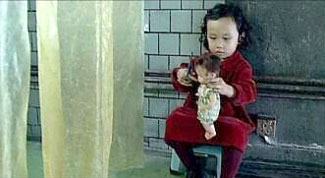 Hong Kong filmmaker Peter Ho-Sun Chan gives us Going Home. The one criticism would be the green color pallet that rarely varies unless for the presence of the little girl in red. It's mostly a film shot in green; even skin-tones were green. Hong Kong filmmaker Peter Ho-Sun Chan gives us Going Home. The one criticism would be the green color pallet that rarely varies unless for the presence of the little girl in red. It's mostly a film shot in green; even skin-tones were green.
As herbs are significant to the story, & because traditional Chinese ghosts often appear in a green mist, the pallet was intended symbolically. It was simply overdone. Still, doesn't matter. The film is great.
Peter Chan is the one director among the three not well known for horror films. Rather, he is famed for such internationally acclaimed romantic dramas as Comrades: Almost a Love Story (1996), & for Going Home he has woven this mightily disturbing tale through a heartbreaking romance.
The actors, especially the two children & three main adult players, are all amazingly good at what they're doing, with such interesting faces that even in moments when little is happening, it's captivating just to look at these people.
And then there's a script that is original, stunningly written, giving these actors something substantive to performe. This film alone makes 3 Extremes II a must-see even if you can't resist fast-forwarding through the first two stories. Watch the third one very, very attentively, as it's one helluva tale.
It begins more or less from the point of view of a little boy whose face is so beautiful & so torn by restrained terror of things he lacks vocabulary to explain.
Cheung (Ting-Fung Li) has lost his mother to some tragedy that occurred before the film begins. He & his dad, mutually grieving, have been forced to move into an ominous run-down apartment building populated by outcasts or eccentrics.
Cheung's especially terrorized by an innocent child (Tsz-Wing Lau), who would seem the least to worry over. She's the tiny girl in red, whose expressive face provides further powerful imagery on the screen.
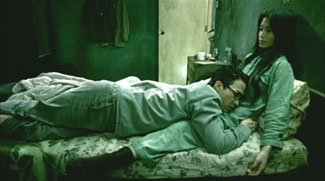 His dad Wai Chan (Eric Tsang) won't listen to his worries, but demands his son stop being a coward. Daily he leaves him alone all day long while he's at work as a police officer. Then one day his boy is missing & cannot be found, & he hugely regrets having paid no attention to the boy's fears. His dad Wai Chan (Eric Tsang) won't listen to his worries, but demands his son stop being a coward. Daily he leaves him alone all day long while he's at work as a police officer. Then one day his boy is missing & cannot be found, & he hugely regrets having paid no attention to the boy's fears.
All we know is that Cheung strove to overcome his terror of the little girl in red next door. When she asked him to play with her, that was the last of him, though a childish drawing of little girl on the hallway's wall suddenly has a second childish drawing beside it, of a boy.
Next door lives a young herbalist, Dr. Yu (Leon Lai), with his paralyzed wife Hai'er (Eugenia Yuan) & their daughter, the little girl in red. But when our new point of view character, Cheung's father, asking after his son, is confronted by the strange herbalist's insistance that he has no daughter, no little girl lives there at all, & he knows nothing about the boy.
It's got to be a lie, so the fretful father breaks into the apartment later on. He discovers that the paraplegic woman seen so rarely outside in her wheelchair, fussed over by the herbalist Dr. Yu, is in reality a stone cold corpse.
it appears that the herbalist has been keeping preserved with herbal concoctions in which he bathes Hai'er daily, addressing her lovingly at all times, & hallucinating her replies. She's been dead nearly three years without decay.
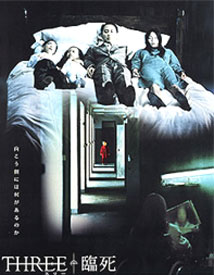 Caught snooping, Wai is wacked on the head, tied up, & held captive by the nutty Yu. The herbalist seems as though he must once have been a really decent guy, but is not working on a fully charged battery. Caught snooping, Wai is wacked on the head, tied up, & held captive by the nutty Yu. The herbalist seems as though he must once have been a really decent guy, but is not working on a fully charged battery.
Wai begs to be released as he has to keep searching for his son. Yu promises to let him go in three days, on the third anniversary of his wife's death. At that time, Yu is convinced, the treatments with herbs will result in Hai'er's resurrection.
The less said of the rest of the tale the better, but believe me, the relationship that develops in those three days between the captive policeman who has lost his son, & the mad herbalist with his undecaying wife, is rivetting stuff. And as a policeman cannot go missing without police turning up to find out why, it's not going to go all that well for Mr. Yu.
Before it's over you'll be simultaneously overawed & heartbroken over the full ramifications of what has unfolded. The stunning tragic conclusion reaches a magnificent height of aesthetic horror of the type Arthur Machen defined as "beauty plus strangeness." No wonder this segment alone (while the other two short films were ignored) received two Golden Horse awards, and one Hong Kong Film Award.
A coda very mysteriously resolves what has become of the missing boy, so it's got two effective climaxes for the price of one, in what has got to be the best ghost story I've seen on film in a great long while.
copyright © by Paghat the Ratgirl
|
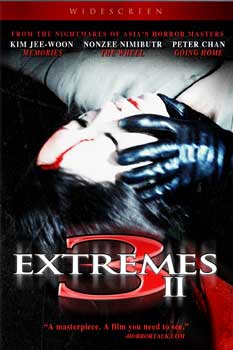

 If its eerie minimalism for Basic Ghost Woman weren't by now such a cliche it might've been effective.
If its eerie minimalism for Basic Ghost Woman weren't by now such a cliche it might've been effective. The "hun lakorn lek" puppeteers are regarded as great artists, their puppets as national treasures, not to be confused with the "khon" street performers who are of low social status who do an imitation of the great art but are regarded as little more than beggars.
The "hun lakorn lek" puppeteers are regarded as great artists, their puppets as national treasures, not to be confused with the "khon" street performers who are of low social status who do an imitation of the great art but are regarded as little more than beggars. Hong Kong filmmaker Peter Ho-Sun Chan gives us Going Home. The one criticism would be the green color pallet that rarely varies unless for the presence of the little girl in red. It's mostly a film shot in green; even skin-tones were green.
Hong Kong filmmaker Peter Ho-Sun Chan gives us Going Home. The one criticism would be the green color pallet that rarely varies unless for the presence of the little girl in red. It's mostly a film shot in green; even skin-tones were green. His dad Wai Chan (Eric Tsang) won't listen to his worries, but demands his son stop being a coward. Daily he leaves him alone all day long while he's at work as a police officer. Then one day his boy is missing & cannot be found, & he hugely regrets having paid no attention to the boy's fears.
His dad Wai Chan (Eric Tsang) won't listen to his worries, but demands his son stop being a coward. Daily he leaves him alone all day long while he's at work as a police officer. Then one day his boy is missing & cannot be found, & he hugely regrets having paid no attention to the boy's fears. Caught snooping, Wai is wacked on the head, tied up, & held captive by the nutty Yu. The herbalist seems as though he must once have been a really decent guy, but is not working on a fully charged battery.
Caught snooping, Wai is wacked on the head, tied up, & held captive by the nutty Yu. The herbalist seems as though he must once have been a really decent guy, but is not working on a fully charged battery.